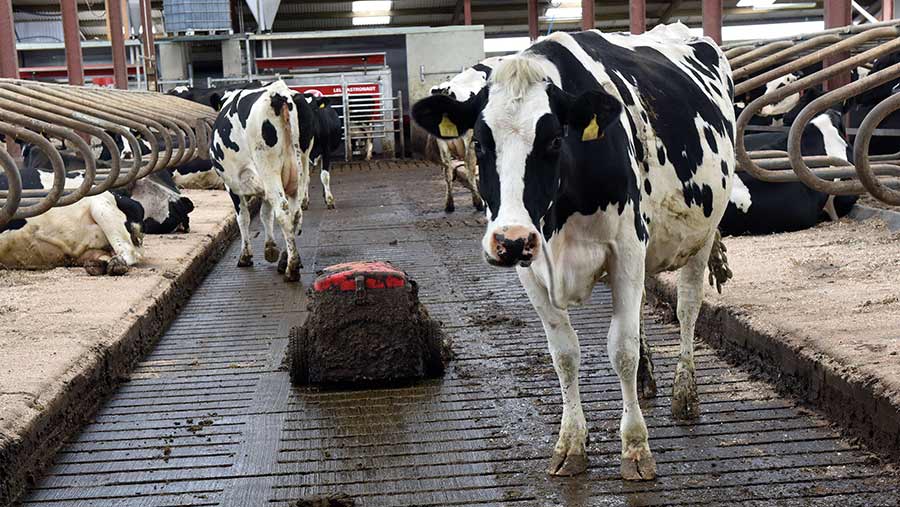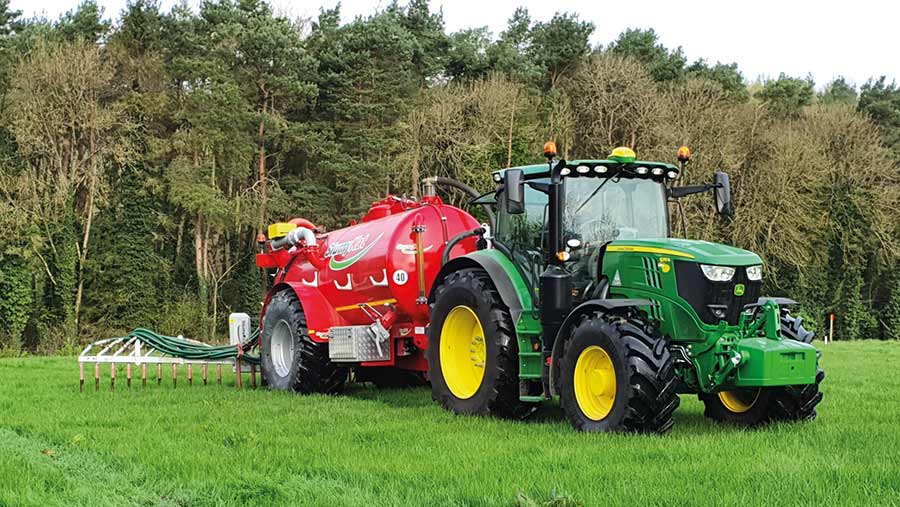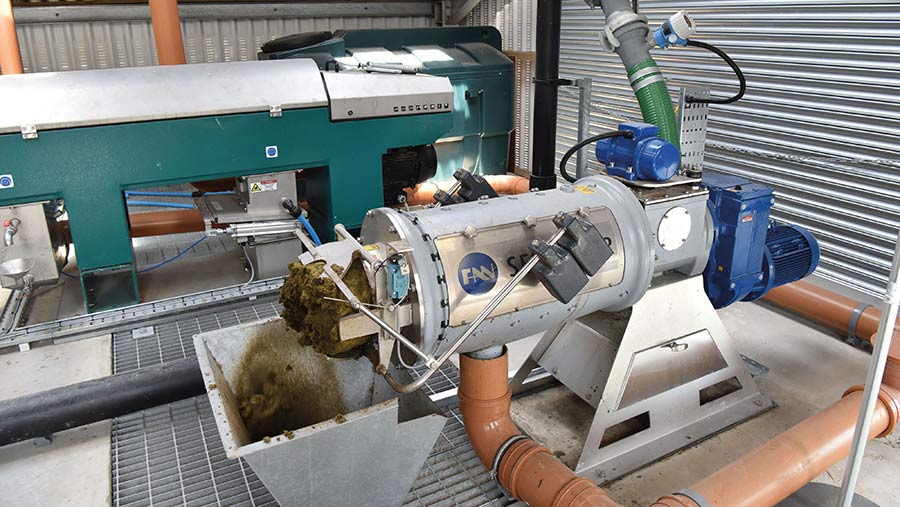How better use of slurry could help reach net zero targets
 © Afbi
© Afbi Researchers in Northern Ireland are exploring how manures can be more than just a waste product by helping reduce overall carbon footprints and associated emissions.
The work, carried out by the Agri-Food and Biosciences Institute (Afbi), forms part of the NI government’s plans to reach net zero.
Agriculture is the country’s biggest greenhouse gas emitter – responsible for 27% of all emissions in 2020, according to the Statistics and Research Agency.
See also: How Cornish farmer cut feed emissions but maintained output
These emissions are made up of methane, carbon dioxide and nitrous oxide – all three of which are often associated with livestock production and, in particular, the management and handling of manure and slurry.
“Agriculture is such an important sector to Northern Ireland. Livestock production is what we do,” says Chris Johnston from Afbi’s agri-environment branch.
“We’ve got more animals than people, so [what we’re focusing on] is [reducing] emissions to air and emissions to water. Our soils are also filling up with nutrients, which isn’t particularly useful for soil or water quality either.”
Financially, it is uneconomic too, he adds: “If you think about it, we’re just filling up [soils] with more and more valuable nutrients.
“What we want is a situation where livestock manures are managed in a way that we can produce energy, recycle the nutrients from them by extracting nitrogen and phosphorus and potentially recirculate those products back into agriculture or elsewhere.
“Phosphorus, for example, is one nutrient we have far too much of. We import a lot – in feed more than fertiliser – and we export less than we import.
“So, the question is: what can we do to try to make livestock agriculture sustainable into the future?”
Nitrogen losses
Afbi’s John McIlroy adds that the nitrogen cycle and losses associated with it have also been fundamental drivers behind the research.
“A lot of our research is on emissions into the air, and in particular we’ve focused on ammonia emissions in recent years because it’s a very significant pathway for nitrogen loss – it’s one of the greatest losses within our nitrogen cycle.
“So essentially, we’re bringing nitrogen fertiliser onto farms and paying a lot of money for it – particularly in light of recent political events and the cost of nitrogen fertiliser – but we’re losing a significant proportion of that as ammonia.”
Not only is that an environmental hazard, but it also results in financial losses for farmers. “That [lost] nitrogen is nitrogen that, had it been stabilised and retained within the fertiliser, would have made its way into the soil [to be] used by the crop.”
With those challenges in mind, the system in place at Afbi’s Hillsborough research centre is based around using anaerobic digestion (AD) and slurry separation technology to make better use of slurry.
While the technology itself is nothing new, Dr McIlroy says it is how this technology – and the subsequent manure and by-products – can be used that makes it interesting from an emissions reduction perspective.
“It’s a holistic system that we’ve been developing at our platform at Afbi Hillsborough, where we have control of the emissions through treatment of the manures.”
So how does it work and how could the system be beneficial for Northern Ireland’s farmers in the long term?
Anaerobic digestion
The first stage of the process is using the slurry from Afbi’s own farm, which is “recycled” via the on-site anaerobic digester.
Animals extract the nutrients they need from feed and grass during digestion. But there is still a residual energy source in the organic matter carbon in the resulting slurry, Mr Johnston explains.

© Afbi
“So what we’re doing is forcing more methane out under an anaerobic environment – anaerobically digesting it and pushing more methane and carbon dioxide out.
“We’re adding extra material to it as well, to up the amount of methane, because it’s the methane that is the energy molecule we are after.”
This enables the reuse of as much material as possible in terms of the carbon, recovering the maximum amount of energy in a final digestate product, which can then be used as a fertiliser, he explains.
“It’s really the same thing as the [unprocessed] slurry, but it will have changed chemically to a degree because the carbon will have reduced slightly due to us converting some to carbon dioxide and taking the methane out.
“There will [also] be higher available nitrogen because of the different bacterial processes that go on within the AD plant.
“All the phosphorous, potassium and nitrogen is still there – really all we’ve done is take out some carbon, oxygen and hydrogen.”
Though the composition may be similar, Dr McIlroy warns that, to keep emissions as low as possible, further processing is needed after AD.
“If you compare digestate to slurry, there’s higher available nitrogen – the nitrogen has changed from organic nitrogen to an inorganic form called ammoniacal nitrogen.
“That ammoniacal nitrogen is more predisposed to ammonia loss.
“The pH of the digestate is also increased slightly when compared with the slurry, so both of those things make digestate more predisposed to ammonia loss than slurry, which is why we really need to have nutrient management technology after AD.”
This could be covering slurry stores or applying the materials to land using low-emission spreading methods.
This technique is something that has been in place at Afbi Hillsborough since 2019 and has been proven to reduce ammonia emissions, adds Dr McIlroy.

© Afbi
Issues such as phosphorous loading on to agricultural fields, and the problems associated with that, also strengthen the argument for this post-digestion management.
Separation
The next step is separation. “This is a physical process whereby solids and liquids will be split to the greatest degree possible – and there are lots of different technologies that can be implemented [to do that],” says Mr Johnston.
Afbi is using a screw-press separator, which is the most common type used in agriculture and works like a pressurised sieve to separate materials.
“The idea is to have as much of the phosphorous in the solid fraction and as much of nitrogen in the liquid fraction – that’s the general goal of the separation process,” explains Dr McIlroy.

© Afbi
“The reasoning for this,” explains Mr Johnston, “is that we want to remove some of the phosphorus from the land base, but we want to leave the [nitrogen] that’s expensive to buy – there’s no point removing all the fertiliser and having to buy it in through a very greenhouse gas-hungry process.”
It is estimated that this technology has the potential to reduce total phosphorus content from slurry or digestate by 20-40%.
Future applications
What happens next with these solids and liquids is an area still being investigated by Afbi.
“This is the bit where we’re now trying to find out what the best route for Northern Ireland agriculture is,” explains Mr Johnston.
With regards to the liquid fraction, management can be as simple as spreading it onto land via a trailing hose or a trailing shoe, says Dr McIlroy.
“You’d reduce a lot of the emissions from [doing] that, but you would still have some.”
There are a number of nitrogen separation technologies that can reduce emissions further, but these are currently only available on a large scale and require further investigation.
“By doing that [nitrogen separation], we’re able to create a nitrogen fertiliser that can be reused and redistributed. But we’re also removing the environmental impact of that nitrogen as we’re capturing, managing and saving it,” says Mr Johnston.
Acidification of the liquid fraction could also help stabilise the nitrogen, which would again reduce emissions when it’s spread on the land, says Dr McIlroy.
“Another example is an acid-stripping system, where you use a sulphuric acid to scrub the ammonia from that liquid fraction, and what you end up with is a liquid ammonium sulphate solution – like a liquid fertiliser – which reduces nitrogen losses.”
There are fewer available options for the solid fraction. “People often forget that when you separate, you have a big pile of solids to deal with as well as the liquid fraction,” he adds.
“On farms in Northern Ireland, particularly big farms, it’s likely that those solids would be destined either for further processing or for export off that farm, as the phosphorous balance might already be exceeded.”
Through further processing, there is the possibility that these solids could be used to make a compost-like substance for horticulture, for example, but Mr Johnston says this is where there are more questions than answers at the moment.
“The question is: what are the most suitable markets? We hear lots about removing peat from horticultural products, so it may be that this is a good alternative,” he says.
However, before this becomes an option for livestock farmers, more needs to be understood about the biosecurity, regulations, nutrition, and value as a fertiliser.
Gas potential
The use of biomethane captured from slurry is a huge area that offers potential to farmers, wider agriculture and associated industries, says the Agri-Food and Biosciences Institute’s (Afbi’s) Chris Johnston.
A recent paper co-authored by Afbi examined the potential for Northern Ireland livestock and agriculture contributing to displacing the import of fossil gas.
Though much of Northern Ireland’s fuel is still based on oil sources, there is a new gas network that is currently distributing 6,500GWh (gigawatt-hour) of gas, explains Mr Johnston.
About 80% of this could be displaced directly from biogas produced through anaerobic digestion, according to economic modelling based on the research findings.
Underused grass and other energy crops could all be co-digested with the slurry, highlighting the huge potential for agriculture to be a big part of the solution for decarbonising energy in Northern Ireland, believes Mr Johnston.
“There’s the opportunity to decarbonise domestic properties and industry transport, and then there’s methane tractors, too – we’ve had one at Afbi to try – so it does seem to be a real opportunity and a way forward to try to make better use of biomethane.”
6 key measures for livestock emissions reduction
A new report gives priority recommendations to focus the ruminant livestock sector in its bid to achieve net zero.
At the top of the list is a call for the standardisation of greenhouse gas (GHG) data to establish baselines and enable benchmarking for carbon footprint audits. Such an “evidence-based” approach would allow for a better assessment of the success of GHG reduction strategies.
“The ruminant livestock industry has a critical role to play in achieving the ambition of net-zero emissions by 2050,” says Jayne Brookman, of the European Institute of Innovation and Technology Food (EIT Food), which published the report.
Called Achieving net zero targets in the ruminant livestock industry in the UK and Ireland, the study brought together experts from government and non-government organisations.
Key stakeholders from the wider agri-food industry included the AHDB, Teagasc, and the Agri-Food and Biosciences Institute.
“For the ruminant livestock industry to transition to net zero, input and support will be required from all players along the supply chain, as well as adoption by farmers,” says Ms Brookman.
“We hope that the recommendations will help a wide range of stakeholders, from farmers to investors and policymakers, to take meaningful action that will support the ruminant livestock industry to achieve net zero.”
Priority recommendations
- Urgent standardisation of GHG data for benchmarks and baselines
- Optimising the age of ruminant livestock slaughter to cut methane emissions
- Introducing policies that reward farmers to support the transition to net zero
- Expanding the network of demonstrator farms to enable research, knowledge transfer and training around new technologies to accelerate the transition to net zero
- Promoting land management strategies (including agroecological and regenerative practices) for net zero
- Improving understanding of the complexity of carbon sequestration to ensure a holistic response
Source: EIT Food
